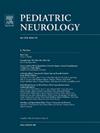Added Value of Microvascular Imaging for the Diagnosis and Monitoring of Strokes in Newborns and Infants
IF 3.2
3区 医学
Q2 CLINICAL NEUROLOGY
引用次数: 0
Abstract
Background
Neonatal/infantile stroke is a catastrophic condition associated with significant mortality and morbidity. Magnetic resonance imaging (MRI) remains the preferred modality for detecting ischemic stroke but has procedural limitations. Microvascular imaging (MVI) ultrasound (US) allows accurate visualization of the microvasculature. We assessed the added value of MVI to improve the detection of stroke diagnosis in neonates and infants.
Methods
We retrospectively identified patients younger than one year who underwent brain US with MVI for suspected or confirmed stroke between January 2020 and June 2023. All patients had confirmed strokes on US and/or subsequent computed tomography or MRI. A pediatric radiologist (reader 1), a neuroradiologist (reader 2), and a pediatric radiology fellow (reader 3), unaware of the results, individually evaluated the US images to detect strokes. We used the McNemar test to determine the difference in responses before and after MVI.
Results
Our cohort had 11 infants, nine boys and two girls (median age 61 days [13.5 to 145.5]). The three readers performed significantly better at stroke diagnosis with MVI (29 correct of 33) compared with grayscale US alone (13 of 33) (P < 0.001). Reader 1 improved from seven of 11 correct diagnoses to 11 of 11 (P = 0.045), reader 2 improved from five of 11 to 10 of 11 (P = 0.025), and reader 3 improved from one of 11 to eight of 11 (P < 0.001).
Conclusions
Our preliminary findings suggest that MVI has potential as a complementary tool to standard brain US protocols for neonatal and infant stroke assessment.
微血管成像在新生儿和婴儿脑卒中诊断和监测中的附加价值
背景:新生儿/婴儿中风是一种与显著死亡率和发病率相关的灾难性疾病。磁共振成像(MRI)仍然是检测缺血性中风的首选方式,但有程序限制。微血管成像(MVI)超声(US)允许精确的微血管可视化。我们评估了MVI在提高新生儿和婴儿脑卒中诊断检测中的附加价值。方法回顾性研究了2020年1月至2023年6月期间因疑似或确诊卒中而接受MVI脑超声检查的年龄小于1岁的患者。所有患者均在美国和/或随后的计算机断层扫描或MRI上证实中风。一名儿科放射科医生(读者1)、一名神经放射科医生(读者2)和一名儿科放射科研究员(读者3)在不知道结果的情况下,分别评估了美国影像以检测中风。我们使用McNemar测试来确定MVI前后的反应差异。结果我们的队列有11名婴儿,9名男孩和2名女孩(中位年龄61天[13.5至145.5])。三名读者在MVI诊断中风方面的表现(33人中有29人正确)明显优于单独使用灰度US(33人中有13人正确)(P <;0.001)。阅读器1从11个正确诊断中的7个提高到11个(P = 0.045),阅读器2从11个正确诊断中的5个提高到11个正确诊断中的10个(P = 0.025),阅读器3从11个正确诊断中的1个提高到11个正确诊断中的8个(P <;0.001)。结论我们的初步研究结果表明,MVI有潜力作为标准脑美国方案的补充工具,用于新生儿和婴儿卒中评估。
本文章由计算机程序翻译,如有差异,请以英文原文为准。
求助全文
约1分钟内获得全文
求助全文
来源期刊

Pediatric neurology
医学-临床神经学
CiteScore
4.80
自引率
2.60%
发文量
176
审稿时长
78 days
期刊介绍:
Pediatric Neurology publishes timely peer-reviewed clinical and research articles covering all aspects of the developing nervous system.
Pediatric Neurology features up-to-the-minute publication of the latest advances in the diagnosis, management, and treatment of pediatric neurologic disorders. The journal''s editor, E. Steve Roach, in conjunction with the team of Associate Editors, heads an internationally recognized editorial board, ensuring the most authoritative and extensive coverage of the field. Among the topics covered are: epilepsy, mitochondrial diseases, congenital malformations, chromosomopathies, peripheral neuropathies, perinatal and childhood stroke, cerebral palsy, as well as other diseases affecting the developing nervous system.
 求助内容:
求助内容: 应助结果提醒方式:
应助结果提醒方式:


